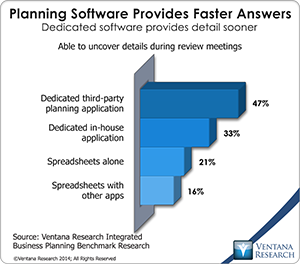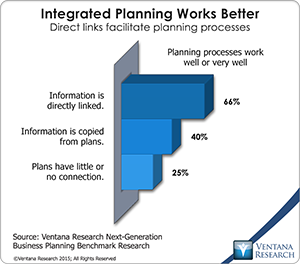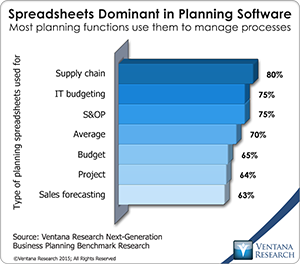Adaptive Insights held its annual user group meeting recently. A theme sounded in several keynote sessions was the importance of finance departments playing a more strategic role in their companies. Some participating customers described how they have evolved their planning process from being designed mainly to meet the needs of the finance department into a useful tool for managing the entire business. Their path took them from doing basic financial budgeting to planning focused on improving the company’s performance. This is one of the more important ways in which finance organizations can play a more strategic role in corporate management, an objective that more finance organizations are pursuing. Half of the companies participating in our Office of Finance benchmark research said that their finance organization has undertaken initiatives to enhance its strategic value to the company within the last 18 months.
We believe that presenting its software as an aid to make the planning process more strategically valuable is a product strategy that is essential for the long-term success of planning software vendors. It was a theme in Adaptive Insights’ recent release of its Adaptive Suite and revenue planning software.
 Companies do many kinds of planning, not just budgeting. They plan sales, they determine what and how they will produce products or deliver services. They plan the head count they’ll need and how to organize distribution and the supply chain. They also produce a budget, which itself is a financial plan. The planning process involves discussions about objectives and the resources and tactics that people need to achieve them. Our benchmark research finds that dedicated applications are more effective tools for planning than are desktop spreadsheets (which nevertheless are still the most widely used technology for planning). For example, dedicated planning software is more able to get to underlying causes behind variances immediately during a performance review meeting. Users can apply the information that’s in the application when reviewing results and adjusting goals and objectives to reflect changes that have taken place in the business. The research shows that organizations that use dedicated software more often can get to the underlying details of the difference between plans and actual results and therefore are more able to make fast decisions about what to do next. Spreadsheets are inherently less capable of drilling down into underlying details.
Companies do many kinds of planning, not just budgeting. They plan sales, they determine what and how they will produce products or deliver services. They plan the head count they’ll need and how to organize distribution and the supply chain. They also produce a budget, which itself is a financial plan. The planning process involves discussions about objectives and the resources and tactics that people need to achieve them. Our benchmark research finds that dedicated applications are more effective tools for planning than are desktop spreadsheets (which nevertheless are still the most widely used technology for planning). For example, dedicated planning software is more able to get to underlying causes behind variances immediately during a performance review meeting. Users can apply the information that’s in the application when reviewing results and adjusting goals and objectives to reflect changes that have taken place in the business. The research shows that organizations that use dedicated software more often can get to the underlying details of the difference between plans and actual results and therefore are more able to make fast decisions about what to do next. Spreadsheets are inherently less capable of drilling down into underlying details.
Adaptive Insights has a suite of planning, analysis, reporting and consolidation applications that mirror the evolution of the business planning category. I coined the term “integrated business planning” more than a decade ago to describe an approach to planning that brings together financially focused budgeting and forecasting activities with various stand-alone functional planning efforts. The objectives of this approach are to provide senior executives with a comprehensive view of future expectations for their business; to set a baseline for performance measurement; to assess performance relative to these baseline objectives; and to periodically adjust objectives and resources in a coordinated, strategic fashion as conditions evolve. Integrating the business planning activities of the various functional groups within a company is best accomplished by providing a single planning environment in which each group can plan its part of the business the way it prefers, compare its actuals to plan using preferred analytical methods and easily report and communicate results within the group. Each planning process can be loosely coupled in that the cadence, items, measures, dimensions and other planning elements fit the needs of that specific part of the business. At the same time, because all planning takes place in a single environment, it’s easy to bring together the necessary information from each of the individual business unit plans to create a consolidated, forward-looking view of the company. It’s also easy to provide control and consistency across planning units by ensuring, for example, that all plans use the same projected benefits costs, commodity prices, exchange rates and other elements that will affect all parts of the organization. Our benchmark research on next-generation business planning finds that companies that integrate their planning by directly linking plans get better results: Two-thirds that have direct links said they have a planning process that works well or very well compared to 40 percent that copy and paste information and just one-fourth that have little or no connection between plans. Well-executed planning is the best way to get everyone onto the same page to ensure that the company is organized in executing the plan. Setting and to a greater degree changing the company’s course require coordination. It enables understanding of the impact of the policies and actions in one part of the company on the rest of the company. Information technology has the potential to make business planning more useful, and to help improve a company’s performance and increase its competitiveness.
impact of the policies and actions in one part of the company on the rest of the company. Information technology has the potential to make business planning more useful, and to help improve a company’s performance and increase its competitiveness.
From a financial management standpoint, it’s essential to be able to project pro-forma balance sheets and cash flows. When all operational planning is feeding the core business model, the future state of a company’s balance sheet and cash flow can be more realistic than when it is only loosely connected. Moreover, it’s possible to quickly and accurately compare the impacts of various operating scenarios on the company’s finances, assess the impacts of various financing alternatives and project how different capital market conditions will affect the company’s overall financing costs across multiple operating scenarios. All of this is possible using spreadsheets, but doing so is far more time-consuming (and therefore impractical) and potentially much less accurate.
Another reason why a dedicated planning application a better planning environment than desktop spreadsheets is that it facilitates the separation of planning into things and the financial aspect of those things: a unit-times-rate structure. While financial planning focuses on money, the rest of the business plans mainly in terms of things: units produced, head count at various pay grades, tons of raw materials and production yields, to name just a few. Having the ability to model units and currency amounts separately makes it far easier to measure performance in ways that are meaningful to each part of the business. In its most simplistic form, it helps planners determine immediately and unambiguously whether variance between the plan and actual results was driven by units, a price or cost variance or both.
Our research on enterprise use of spreadsheets shows that companies that use spreadsheets for forecasting, planning and budgeting usually spend much more time in analyzing and reporting results than users of more appropriate tools do. Dedicated software automates this process, enabling finance departments and other functional units to spend less time on repetitive tasks while providing accurate and consistent information to executives and managers. Adaptive Insights recently added to its suite Office Connect, which facilitates creating and updating reports in Microsoft’s Excel, Word and PowerPoint  applications, enabling departments to operate more efficiently and speed the availability of performance reports. For example, using the software, standard monthly tables and charts can be instantly updated each month to speed the production of spreadsheets, narrative reports or presentation decks for monthly board meetings.
applications, enabling departments to operate more efficiently and speed the availability of performance reports. For example, using the software, standard monthly tables and charts can be instantly updated each month to speed the production of spreadsheets, narrative reports or presentation decks for monthly board meetings.
I have long advocated the use of dedicated planning applications rather than desktop spreadsheets for handling planning processes. The inherent technology limitations of spreadsheets make them a poor choice because they consume time needlessly and prevent organizations from being able to forecast, plan, analyze and replan effectively. Yet spreadsheets remain the leading technology used for planning. Our recent planning research finds that, across 11 different types of business planning, on average seven out of 10 companies use spreadsheets. I recommend that all midsize and large companies consider replacing spreadsheets with a dedicated planning application that provides a unified environment for planning across the entire enterprise. Midsize companies and midsize divisions of large enterprises should consider Adaptive Insights for this role.
Regards,
Robert Kugel – SVP Research














